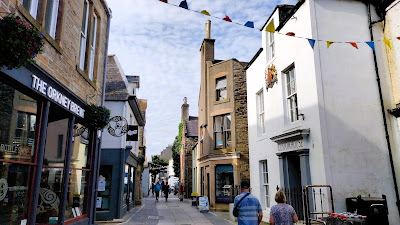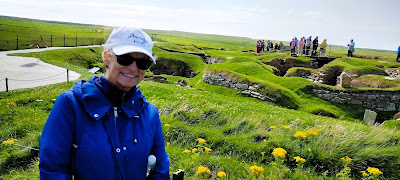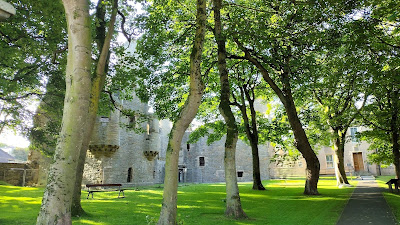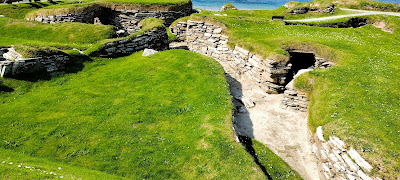It's no surprise that cancellation of our final port in Iceland disappointed Julie and me.
At least we had been to Seydsifjordur on a prior cruise, so if we had to choose one to miss, that would have been it. Last time the weather had been perfect, and our captain had shared that stormy weather forced this cancellation, so perhaps it was for the best.
The captain atoned for skipping that port by finding a calm waters in an unanticipated sunny spot in the Atlantic Ocean on our way to the Orkney Islands.
We enjoyed walking laps around the ship, lounging in lounge chairs and dining al fresco under the clear blue skies.
Entertainment and other activities were along the lines of our sea days cruising toward Iceland.
Upon arriving at our next port, Julie and I walked a couple of miles to Kirkwall, a former Viking settlement. The paved road led us past green fields.
It would be possible to find ways to spend the day in Kirkwall, particularly if you enjoy the foodie experience sampling local cuisine in ports. A bus system carries tourists further afield, but doing so always requires being certain to return well before sailing time.
A friend recently said her impression of cruising was that it was nothing more than a floating hotel stopping at ports for passengers to go shopping.
As I said at the time, Julie and I almost never intentionally shop for anything while on vacation, which immediately dispels that notion. But if we have time, we like to stroll through port towns even when we have excursions scheduled, as we did in Cornwall.St. Magnus Cathedral
In Kirkwall, we visited the northernmost cathedral in Scotland, St. Magnus Cathedral, founded in 1137 by Viking Christian Earl Rognvald, in memory of his religious uncle, Earl Magnus of Orkney, who had been martyred.
It's interesting to note that Vikings by this date had become Christian instead of pagan. It's an indication of how the culture of Britain seemed to somehow conquer the conquering powers who settled in the British Isles, maintaining their religion and evolving English language while changing Britain's literal DNA.
Long story short, St. Magnus had been one of two Earls sharing rule in Orkney. They had an epic falling out, as Vikings might. Scheduled to meet with two ships each under a flag of truce to work things out on a small island, his opponent Earl Håkon came with eight ships instead and captured Magnus.
He offered Magnus his choice of exile or prison. Viking Chieftains wanted the issue resolved once and for all, insisting one of the Earls die.
Earl Håkon's regular executioner refused to carry out the sentence against the pious Earl Magnus. A cook ordered to kill Magnus hit the soon-to-be-sainted earl on the head with an axe, probably in the same manner he would butcher an animal.
Gruesome!
Visions and healings were attributed to the site.
We report, you decide.
In any case, it's an impressive church, with a free audio-visual presentation during operating hours.
Bishop's Palace
Across from the Cathedral is the impressive Earl's Palace (aka Bishop's Palace), which was bathed in royal intrigue before deteriorating into ruins.
Beginning in 1601, Earl Patrick Stewart, a royal cousin, began borrowing massive sums for lavish living and rebuilding the pre-Reformation Bishop's Palace on this site into a new, more magnificent castle.
As a frame of reference, construction began during the waning years of the reign of Queen Elizabeth I and continued into the reign of King James I (aka King James VI of Scotland). In 1606, the jig was up. Like a medieval Great Gatsby who ran out of funds to finance his lifestyle of the rich and famous, Patrick Stewart ran out of lenders and whatever royal goodwill he had wielded extravagantly.
This Earl was cut off financially and subsequently executed. Needless to say, he was not considered to be a martyr like St. Magnus.
As with the Bishop's Palace in St. Davids, Wales, even in ruins the structure is beautiful.
Continuing our visit to Kirkwall, we walked down the street through the historic village.
It didn't require hours of exploration based on our experience. Keep in mind we aren't shoppers and weren't hungry, having eaten a delicious breakfast before going ashore.
The significance of the etched windmill pattern we noticed on the windows of a public building was illuminated later in the day by our guide.
In the Orkney Islands, wind power generates 130% of their energy needs, so they are net exporters of electric energy.
This is not a bustling metropolis by any means, and we easily found the bus stop right where it was supposed to be, at a small tourist information center.
Many fellow passengers were arriving on the free town-furnished bus back to the ship for lunch.
After dining, we headed toward the meeting place for the Princess shore excursion we'd booked for the afternoon, arriving with a minute or two to spare.
Walking with our group down a ramp while debarking the ship, however, a wind gust swept my hat off. It wafted down into a secure, gated-off area beside the ship.
At the bottom of the ramp, I started to slip through a gap to retrieve my cap myself, but I was stopped by port security. A Princess crew member offered his service but was also stopped. Fortunately, an approved security guard did retrieve my hat before it blew into the water.
By that time, our group had boarded one of the buses, but which one?
Despite meeting on the ship, we once again had to find the right bus among many possibilities.
It didn't take long to figure out, but the bus was mostly full when we located it. Walking down the aisle, no two seats together remained except in the far back. A wide woman with a cane on her lap sat sprawled across the middle of the back seat, which what should have provided at least two spaces on each side.
We stood there, indicating two seats to the left of her. She sighed and swiveled her legs slightly, though not enough to allow us to squeeze by. All the while, she gave us a rather haughty look.
I was more direct. "Could you slide to the side so we can sit together?"
"I'm not moving," she said with a bit of a sneer. "You're welcome to slip past me if you like."
Realizing what unpleasant company she would be for a long tour, not to mention how difficult it would be to get off the bus every time we arrived at a stop, Julie and I simply pivoted around and found individual seats separated by a dozen rows.
We decided to not allow that to spoil our tour. Vikings undoubtedly dealt with greater hardships.
The young woman sitting by the window in the seat next to mine wore ear buds and focused on her video game for the entire drive. She turned it off only at our tour stops, so I just looked at the scenery. It was a pleasant ride after all.
Our knowledgeable guide shared lots of wonderful information throughout the ride about the region, including ancient history and recent archaeological findings. We caught a glimpse of rather recent, literally ground-breaking find, Ness of Brodgar. A twenty-year dig will now be covered to preserve the find for future generations.
Our guide said that archaeologists like to leave something for future generations to develop with newer technology, so it will covered for twenty years, protecting it from the elements.
We were traveling through the Heart of Neolithic Orkney World Heritage Site.
Standing Stones of Stenness
Ring of Brodgar
Skara Brae
Skaill House
And That's the Rest of the Story
Later in the afternoon, I heard a discussion among the other women in the back of the bus. For whatever reason, they decided to speak loudly about what a big responsibility women had to get out the vote for the woman running for President. Women had dropped the ball the last time they had this opportunity.
At some point, a young lady referred to the woman we encountered while trying to find two seats together --- who still had the entire back row intended to seat five riders to herself --- "She's too modest to say this..."
Oh, brother, I thought. This about a woman too entitled to share a seat large enough for five adults
Think serenity. Ommmm...
It turned out the rude woman was the daughter or granddaughter (I don't remember which) of a famous Los Angeles politician. That certainly explained her sense of entitlement. I don't want to publicly impugn her famous member family, who is now deceased, so I will withhold his name. After all, she might have lied to her acquaintance.
At least they waited to have their loud political discussion until that part of the drive home when the guide allowed free quiet time to rest.
It gave me something to discuss with Julie at happy hour back on board in the comforts of our floating home away from home. And another delight-filled evening began...

















































































































































No comments:
Post a Comment